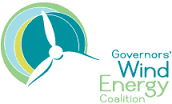Republican and Democrat governors are pressing U.S. Senate and House leadership in an effort spur action on tax incentives used to grow the country’s wind energy industry. Washington Democrat Gov. Jay Inslee and Iowa Republican Gov. Terry Branstad, Chairman and Vice Chairman respectively of the Governors’ Wind Energy Coalition, co-signed a letter insisting federal policymakers “support timely extensions” of the Production Tax Credit (PTC) and Investment Tax Credit (ITC). The PTC is the primary federal incentive building more new U.S. wind farms while the ITC is the primary incentive attracting private investment developing the nation’s offshore wind energy resources.
“This bipartisan letter is a reminder that the nation’s governors are on the front line of the nation’s  energy future and have a vital role in planning states’ future,” said American Wind Energy Association (AWEA) CEO Tom Kiernan. “They see first-hand how investing in the wind resources in their states benefit local economies and create opportunities for job growth. To them the decision to extend these incentives is more of an economic one than a political one. We look forward to working with all the governors to maximize the benefits of wind power to their states.”
energy future and have a vital role in planning states’ future,” said American Wind Energy Association (AWEA) CEO Tom Kiernan. “They see first-hand how investing in the wind resources in their states benefit local economies and create opportunities for job growth. To them the decision to extend these incentives is more of an economic one than a political one. We look forward to working with all the governors to maximize the benefits of wind power to their states.”
According to AWEA 23,000 jobs were added in 2014 and there are currently $23 billion worth of new wind projects under development. But, cites Kiernan, that momentum is increasingly placed at risk as Congress delays action on passing policy capable of creating long-term market certainty.
“These tax credits have made possible the robust growth of the American wind industry and thousands of renewable energy jobs in recent years, with substantial economic returns to our states and the nation,” the governors’ letter reads. “But these gains are at risk today because ongoing federal policy uncertainty continues to hamper the further development of the nation’s wind industry.”
The governors’ letter stressed that multi-year extensions of the renewable energy PTC and ITC would avoid stagnating a wind-supported domestic manufacturing sector that includes thousands of American jobs at 500 facilities across 43 states.
 The governors’ letter referenced the U.S. Department of Energy’s (DOE) new Wind Vision report showing wind energy could double from where it is today to supply the U.S. with 10 percent of its electricity needs by 2020, supply 20 percent by 2030 and become one of the leading sources of electricity in the U.S. by 2050.
The governors’ letter referenced the U.S. Department of Energy’s (DOE) new Wind Vision report showing wind energy could double from where it is today to supply the U.S. with 10 percent of its electricity needs by 2020, supply 20 percent by 2030 and become one of the leading sources of electricity in the U.S. by 2050.
“We expect the bills that emerge from these committees will provide the wind industry with tax certainty and a framework for the nation’s electrical transmission system that will bring renewable energy to all Americans, no matter where they live,” added Kiernan.
Last week the DOE released “Enabling wind power nationwide,” a new report that builds off of Wind Vision and shows how advanced wind turbine technology unlocks wind development opportunities in all 50 states. However, stresses Kiernan, without long-term, stable federal policy, the continued innovation and further wind cost reductions needed to continue opening new opportunities for wind energy deployment in every state could be placed in jeopardy.

